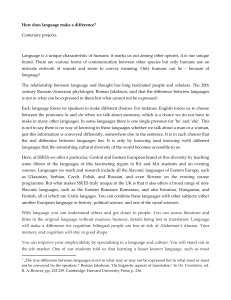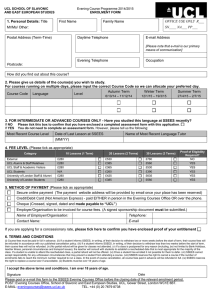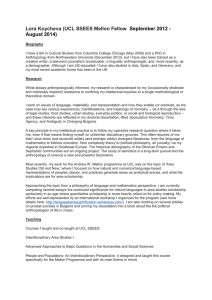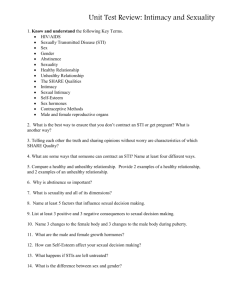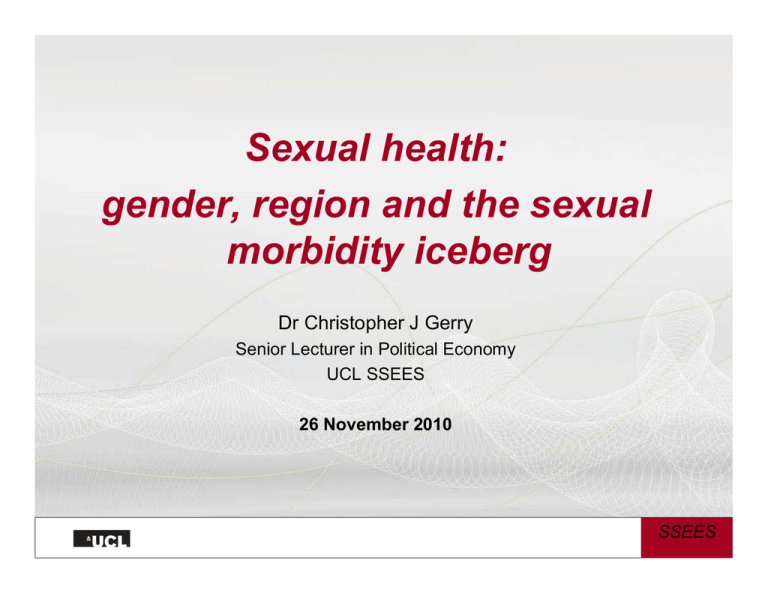
Sexual health:
gender, region and the sexual
morbidity iceberg
Dr Christopher J Gerry
Senior Lecturer in Political Economy
UCL SSEES
26 November 2010
SSEES
Contents
•
•
•
•
•
•
What is SALLEE?
SALLEE so far
This research
The data
Preliminary analysis
Conclusions
SALLEE
SSEES
SALLEE:
Sexual Attitudes & Lifestyles of London’s East
Europeans
An interdisciplinary, cross-faculty project involving
UCL Centre for Sexual Health and HIV Research
and
UCL School of Slavonic and East European Studies
Funded by
Medical Research Council
North Central London Research Network
SALLEE
SSEES
SALLEE - Motivation
• EU accession resulted in large migratory influx of
Central and East Europeans (CEE) into the UK
• Previous large-scale migrations posed challenges to
and necessitated changes in public health delivery
• Limited research on the sexual and health
behaviours and attitudes of CEE migrants in the UK
SALLEE
SSEES
SALLEE - Motivation
• Demographic profile suggests likely to be sexually
active and to have reproductive ambitions
• Drawn from countries and regions with diverse, but
often high, prevalence of STIs and HIV
• And little known about their patterns of health
service use or uptake of safer sex measures
• SALLEE set out to establish a deeper understanding
of the sexual lifestyles, reproductive health risks and
health service needs of the CEE communities
SALLEE
SSEES
SALLEE - Methodology
• Community, clinic and web-based surveys between
July 2008-March 2009 (18+ CEE migrants)
• Self-completed questionnaires using hand-held
computers (or web), translated into 11 languages
• Convenience sampling stemming from detailed
social and community mapping exercises
• Community sample drawn from Hammersmith and
Fulham; and Newham.
• Clinic sample drawn from clinics in North London
• Followed up with in-depth interviews
SALLEE
SSEES
SALLEE - Methodology
• Community sample 2,276
• Clinic sample 357
• Web sample 372
• This was supplemented later with additional in-depth
interviews and web surveys targeting the gay CEE
population
SALLEE
SSEES
SALLEE – so far
• Publications and submissions:
•
•
•
•
•
Methodology
Sexual risk among MSM
Attendance at sexual health clinics
Sexual and HIV risk behaviour
Reproductive health among women
SALLEE
SSEES
This work
• Focuses on sexually active heterosexual men and
women
and aims
• (i) To explore whether there are significant
regional/country differences
• (ii) To examine more closely the differences
between males and females
• (iii) To investigate whether there is evidence of a
sexual morbidity ‘iceberg’
SALLEE
SSEES
The data
• Draw on data from all sampling arms
• Keep only those reporting sexual activity during the
last 12 months who are not bisexual or gay
• Who live in London and are from one of the 10 CEE
countries
• 947/1211 heterosexual males/females
• 3 main population groups:
• Lithuanian, Polish and Romanian
SALLEE
SSEES
Distribution by gender/region
Male
(% of male sample)
Female
(% of female sample)
Lithuania
Poland
Romania
Other
Total
134
457
210
146
947
(14.2)
(48.3)
(22.2)
(15.4)
249
556
204
202
(20.6)
(45.9)
(16.9)
(16.7)
SALLEE
1211
SSEES
Characteristics
Lithuania
Poland
Romania
Age
28.3
28.7
29.2
Male (%)
35.0
45.1
50.7
Basic education (%)
11.0
5.7
8.2
Degree (%)
30.0
37.4
25.2
Years in UK
3.31
3.04
1.83
Religion (%)
80.5
78.7
88.3
In relationship (%)
59.0
50.2
62.2
Children (%)
42.7
28.8
35.3
SALLEE
SSEES
Sexual Attitudes (% agreeing)
Lithuania
Male
Female
Same sex, sexual
relations unacceptable
49.3
34.9
More likely to get HIV
here than at home
37.3
Aborting unwanted
pregnancies is not
acceptable
Pre-marital sexual
intercourse is not
acceptable
Poland
Male
Romania
Female
Male
Female
39.0
19.1
60.0
51.0
40.6
48.8
46.2
45.2
40.7
33.6
33.3
27.1
29.1
30.5
29.4
6.7
7.2
3.3
3.4
4.8
7.8
SALLEE
SSEES
Sexual Practices (%)
Lithuania
Poland
Romania
Male
Female
Male
Female
Male
Female
Sex in last 4
weeks
81.1
86.6
76.8
83.9
67.0
89.1
2+ partners in last
year
57.5
24.1
47.9
28.2
52.5
18.6
2+ new partners
in last year
47.8
19.0
33.3
19.8
34.5
12.8
SALLEE
SSEES
Sexual Risk (%)
Lithuania
Poland
Romania
Male
Female
Male
Female
Male
Female
2+ concurrent
partners in last
year
27.1
8.2
21.0
8.5
33.8
4.2
Multiple partners
without condoms
in last year
17.9
6.8
18.8
11.3
13.3
2.9
32.1
0.0
30.0
0.0
50.0
0.0
3.9
2.9
3.4
1.3
7.2
1.5
Ever paid for sex
Ever been paid for
sex
SALLEE
SSEES
Contraceptive use in the last year
(you or partner) (%)
Lithuania
Condoms
Oral contraceptive pill
IUD (Mirena / coil)
Injection or planted capsule
Safe period
Withdrawal
Emergency contraception
Other
None
Poland
Romania
Male
Female
Male
Female
Male
Female
39.7
28.4
38.2
26.5
52.0
27.4
26.0
30.5
25.5
38.6
13.6
31.6
0.8
8.5
1.8
3.8
0.5
3.7
0.0
1.3
0.2
1.9
0.0
0.0
3.1
1.3
5.4
3.8
0.5
5.3
12.2
15.7
13.5
10.8
13.6
16.8
0.8
2.1
1.8
4.9
3.4
4.2
5.3
3.4
2.5
3.4
4.4
3.2
9.9
6.4
7.5
5.5
9.2
5.8
SALLEE
SSEES
Use of health services (%)
Lithuania
Registered with GP
Attended GP in last year
GP – sexual/reproductive
health
HIV test ever
HIV test in UK, if ever
Sexual health clinic in UK
Family planning clinic in
UK
Obtained contraception
from ‘NHS’ services in
last year
Poland
Romania
Male
Female
Male
Female
Male
Female
41.8
75.9
47.1
71.9
34.8
61.8
26.1
59.8
31.4
60.3
18.6
46.3
4.5
22.6
3.5
29.1
1.9
23.2
31.5
36.0
32.5
36.3
38.8
40.7
27.5
56.3
21.5
62.1
7.5
27.9
17.8
20.3
4.7
21.5
5.8
10.3
2.4
24.5
2.7
25.3
3.9
7.0
7.5
33.6
5.9
39.8
6.8
21.0
SALLEE
SSEES
Sexual Health and HIV (%)
Lithuania
Male
Female
STI
9.7
16.9
HIV
1.5
0.0
Poland
Male
SALLEE
Romania
Female
Male
Female
5.0
12.4
9.5
13.2
2.6
2.2
0.5
0.5
SSEES
Describing the data
•
•
•
•
Polish migrants more highly educated
Lower proportion of Lithuanian males
Lithuanians been here longer
Religious affiliation similar but far lower ‘attendance’
among Lithuanians
• Widespread intolerance of gay sex
SALLEE
SSEES
Describing the data
• Sexually active population
• High number of partners and concurrency
(compared to equivalent UK data)
• High proportion of paying for sex (UK approx 15%)
• Discrepancies in ‘knowledge’ of contraception used
• Women more integrated into health system and
engaged with sexual health services
• Lower reported STI incidence than UK average
(other than Lithuanian females)
SALLEE
SSEES
Analysis
• What determines (reported) STI infections?
• Characteristics, behaviour, interaction with health
services
• What explains the difference in (reported) STI
between men and women?
• Is there a sexual morbidity iceberg?
• Methodological problems
• STI and risk behaviour may be jointly determined
• i.e. risk behaviour endogenous
SALLEE
SSEES
What determines STI?
• Probit STI regressed on:
(age, years, religious participation, religious affiliation, relationship, children;
drink, concurrent relationship, multiple non-condom partners;
NHS contraception; Lithuanian, Romanian, Polish)
• Male STI more likely for Lithuanians and Romanians and
among those drinking more, having concurrent
relationships and multiple non-condom partners.
• Males in the UK for longer, participating actively in
religion and with children also more likely to have an STI
• Neither age, nor being in a relationship, nor interaction
with health services appear to influence reported STI
incidence.
SALLEE
SSEES
What determines STI?
• Female STI more likely for Lithuanians than Poles or
Romanians and among those with multiple non-condom
partners.
• But drink and concurrency are not significant
• While engagement with the NHS for contraception is,
suggesting it is a matter of reporting
• Older females and those reporting a religious affiliation
are more likely to have an STI, but those practising
religion are less likely, as are those with children
SALLEE
SSEES
Methodological issue
• Joint determination of STI incidence and risk
behaviours
• Therefore need to find instruments that predict risky
behaviour but not STIs directly
• Use relationship status and whether take recreational
drugs
• These both turn out to be strong predictors of
concurrency and/or multiple non-condom partners
• And thus valid instruments
• The results using this approach are broadly the
same
• Lithuanians still most likely to have STI
SALLEE
SSEES
The sexual morbidity iceberg
• ‘Morbidity icebergs’ increasingly important in global
health issues
• Refers to hidden / unreported illnesses
• e.g. recent UK report on the hidden incidence of
cancer
• Vital for public health policy
• In this case:
• Men are reporting significantly riskier sexual health
behaviour
• Are reporting lower interaction with public health
services
• And lower incidences of STI
SALLEE
SSEES
The sexual morbidity iceberg
• Investigate this by decomposing the male – female
estimates
• In particular: asking, what would the STI gap look like if
men had the same behavioural characteristics as women
• The estimates predict that given that males drink more,
have more concurrent sexual partners, have more sex
without condoms, there should be a substantial male STI
gap – since all these factors predict STIs
• Yet, there is a 7% point female STI gap
SALLEE
SSEES
The sexual morbidity iceberg
• It turns out that approximately 2/3 of this gap is due to
the under utilisation of sexual health services by males
• And it is not sexual health services that ‘cause’ STI,
rather that they record STI
• That is, male STI among East European men appear to
be substantially under-reported
• There may be a large sexual morbidity iceberg
SALLEE
SSEES
Conclusions
• Polish, Lithuanian and Romanian men and women
are engaging in high levels of sexual behaviours
associated with risk
• Males in particular are not integrating into UK public
health services
• And there is likely to be widespread under-reporting
of STIs among CEE men
SALLEE
SSEES
Conclusions
• Lithuanian, Polish, Romanian men and women also
report both:
• High levels of mobility (2+ trips home per year)
• And indicate sexual activity with men/women from
their home country
• Integrating CEE migrants more successfully into UK
public health services will benefit both UK and home
countries
• Large potential benefits to trans-national health care
and disease surveillance
SALLEE
SSEES
Next steps
• Further work on decompositions and simulations
• Analysis of in-depth interviews, in particular for
evidence on the under-utilisation of public health
services, among males
SALLEE
SSEES

